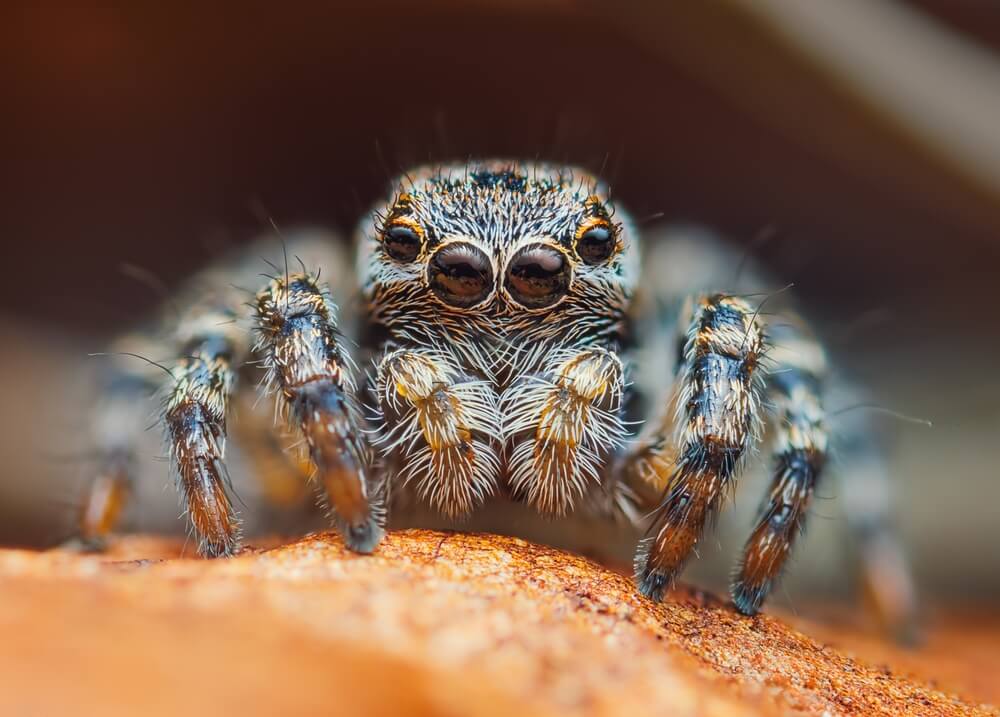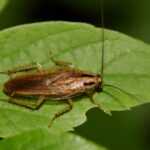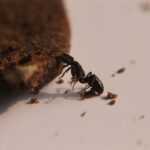Jumping Spider: Tiny Acrobat with Big Personality
Jumping spiders are tiny, agile arachnids known for their incredible jumping abilities and sharp vision. Unlike most spiders, which tend to be nocturnal and build webs, these spiders don’t rely on webs to catch prey; instead, they actively hunt during the day. Their uniqueness lies in their eight eyes, which provide almost 360-degree vision, making them efficient predators. In this article, we explore the fascinating characteristics, habitats, behaviors, and different species of jumping spiders.
Key Takeaways
- Jumping spiders have exceptional vision with four pairs of eyes, enabling nearly 360-degree sight and precise hunting.
- These spiders are adaptable and can thrive in various habitats globally, showcasing their resilience and ability to hunt effectively in diverse environments.
- Their mating rituals involve complex displays and dances, with males attracting females through visual signals, enhancing their reproductive success.
Characteristics of Jumping Spiders
Jumping spiders are easily identified in the spider community by their unique eye configuration, which includes eight eyes arranged in four pairs. The most prominent pair is situated at the forefront, providing them with excellent depth perception and a nearly complete panoramic view of their surroundings. This superior visual capability plays an essential role in their hunting strategies and navigation abilities, as it enables precise tracking and focusing on prey.
Renowned for their incredible leaping prowess, these spiders boast an intricate internal hydraulic system that empowers them to extend their legs swiftly for jumps. Jumping spiders vary widely in body size across different species. They can be as small as 1 mm or grow up to 25 mm long. Their ability to jump several times over compared to their own body length regardless of size makes them both agile navigators and potent predators.
While most jumping spiders have few hairs, there are a few species that possess hairy bodies, emphasizing the diversity within the Salticidae family.
One particular well-recognized species within this group is the Bold jumper, noted for its distinctive black hue and sizable eyes—an attribute celebrated among arachnid aficionados. The jumping aptitude coupled with its extraordinary vision provides a compelling illustration of the intriguing evolutionary adaptations exhibited by jumping spiders.
Habitat and Distribution
Jumping spiders display a remarkable ability to adapt to various living conditions. Preferring warm and arid climates, they are often located in areas where sunlight is plentiful, using these bright spots for hunting and orientation. These agile spiders have established their presence across the globe, withstanding all but the harshest polar environments, which showcases their incredible capacity for survival.
Different jumping spider species exhibit preferences for distinct habitats. Some prefer residing on tree bark while others opt for man-made structures such as walls or fences. They also make their homes among an assortment of natural features like grassy expanses, stony patches, shrubbery, and diverse forms of leaf litter.
Adapting seamlessly whether it’s within forests or wetlands—or even amongst human creations—jumping spiders successfully establish themselves in a broad spectrum of ecological niches around the world.
Behavior and Hunting Techniques
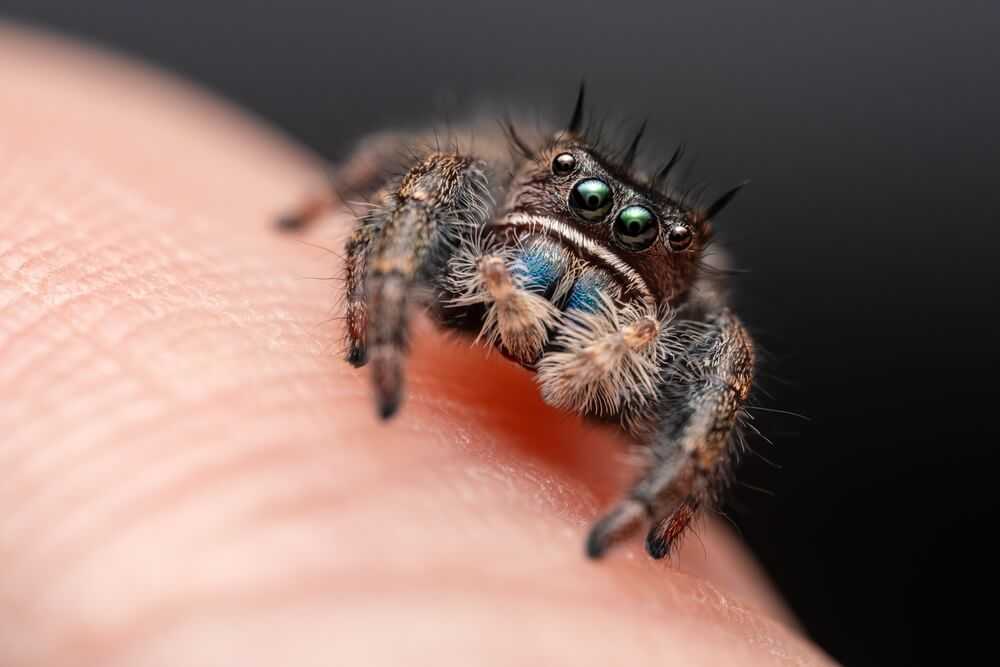
Jumping spiders stand out as active predators, using their superior vision and nimbleness to pursue and seize their quarry. These arachnids diverge from many of their kin who spin webs, opting instead for diurnal hunting when the warmth peaks between late morning and afternoon. Their sharp eyesight is key to effectively cornering and ambushing prey, placing them among the most formidable hunters in the spider community.
In addition to their hunting prowess, jumping spiders utilize web retreats not only to rest and hibernate but also to lay eggs, highlighting the importance of these structures for their reproductive process.
The intricate strategies they employ during hunts speak volumes about their sophisticated visual prowess. Equipped with prominent anterior eyes, these spiders are adept at gauging distances precisely before leaping onto unsuspecting victims.
For instance, bold jumpers exemplify solitary pursuit tactics without resorting to web construction. They proactively chase down a variety of insects — some even being crop pests — thus demonstrating both versatility and efficiency as natural predators within agricultural ecosystems.
How They Catch Prey
Jumping spiders possess an exceptional set of skills when it comes to hunting their prey, with their ability to jump being particularly noteworthy. They are capable of propelling themselves up to 40 times the length of their bodies thanks to rapid changes in hemolymph pressure within their limbs—this allows them a stealthy and highly effective approach for capturing unsuspecting insects like fruit flies among other potential prey items.
While they embark on these impressive jumps, jumping spiders utilize silk draglines as a safety measure to stabilize themselves and ensure that they can firmly land after making such bold moves. Although weaving webs is not part of their strategy for trapping food, it’s clear from how adeptly they ambush small insects that these arachnids excel at active hunting.
Lastly, once they’ve secured their catch using both agility and skillful leaps, the spiders administer venom through bites from sharp fangs—a swift act that paralyzes the victim in mere seconds. This lethal efficiency underscores why jumping spiders are considered formidable hunters despite lacking complex web constructions typical of other spider species.
Interaction with Other Spiders
Jumping spiders are recognized for a variety of distinct behaviors that set them apart from other spider families. Within the diverse Salticidae family, there exist species renowned for their intricate courtship performances and confrontational territorial disputes. These behavioral traits underscore their versatility and sophisticated social engagements within their respective ecological habitats.
Elaborate courtship displays are characteristic of certain species, involving dance routines and visual exhibitions to entice potential partners. A select number of these species use such elaborate tactics not only as part of mating rituals, but also to communicate with or intimidate competing males.
These various activities exhibited by jumping spiders reflect both their adaptability in different environments and complex interactions socially, distinguishing them significantly from numerous other species of spiders.
Jumping Ability
Jumping spiders are renowned for their impressive jumping ability, which allows them to cover distances of up to 10-40 times their body length in a single leap. This remarkable feat is made possible by the powerful muscles in their back legs, which enable them to generate a tremendous amount of force relative to their body size. Adult male jumping spiders, in particular, are known for their impressive jumping ability, which they use to catch prey and attract females. In fact, some species of jumping spiders can jump as high as 50 times their own height, making them one of the most impressive jumpers in the animal kingdom.
Defense Mechanisms
Jumping spiders have a range of defense mechanisms to protect themselves from predators and other threats. One of their most effective defenses is their ability to jump away quickly, using their powerful back legs to propel themselves to safety. They also have a distinctive way of raising their front legs in a defensive posture, which can deter potential predators. Additionally, jumping spiders can release a cloud of silk threads to confuse and distract predators, giving them time to escape. Some species of jumping spiders also have brightly colored or strikingly patterned bodies, which can serve as a warning to potential predators that they are distasteful or toxic.
Reproduction and Life Cycle
The developmental process of jumping spiders is as intriguing as their active behavior, comprising three key phases: the egg sac stage, the spiderling phase, and reaching maturity. The males often mature sexually faster than their female counterparts and can be identified by distinct physical characteristics that become prominent during mating rituals. Once the male has successfully wooed a female with elaborate courtship displays, they typically mate within one to two weeks.
If a pregnant female is caught, there is a potential for acquiring a large number of baby spiders, emphasizing the responsibility involved in caring for or releasing them.
In pursuit of winning over females, males engage in various actions such as producing visual signals and executing dance-like movements. The time taken for mating varies significantly across different species and environmental conditions. It may take anywhere from a mere five minutes up to an entire hour or even longer.
Upon successful mating, the spiderlings set off on their own journey into independence where they begin hunting solo. This period signifies the beginning of each individual’s life as skilled predators in their respective territories.
Egg Sacs and Hatching
Jumping spiders utilize a silken web or secured spot laid by the female to incubate their eggs. These egg sacs, potentially holding up to 300 creamy yellow eggs each, are pivotal for the hatchling spiderlings’ development and typically take approximately one week to ten days before hatching occurs.
The duration of this critical incubation phase for both the egg sac and its developing occupants can extend from two weeks up to a month. Once it concludes, there might be an additional waiting period of about a month before these young spiders finally disperse, fully equipped and ready for life on their own as proficient predators.
Mating Rituals
Adult jumping spiders engage in elaborate mating displays, which include a series of dance-like movements and the creation of vibrations to catch the attention of potential female mates. Should the female show interest, they can quickly proceed with the copulation. These complex rituals are vital for adult jumping spiders to secure successful mating.
Following this process, females possess the ability to retain sperm internally. This adaptation gives them the flexibility to produce several egg sacs over a period ranging from immediately after copulation up until two weeks later. Such an attribute greatly increases their chances for effective procreation.
The intricate courtship performances and fecundity strategies exhibited by jumping spiders reflect their sophisticated behavioral patterns and versatility within their ecological habitats.
Common Species of Jumping Spiders
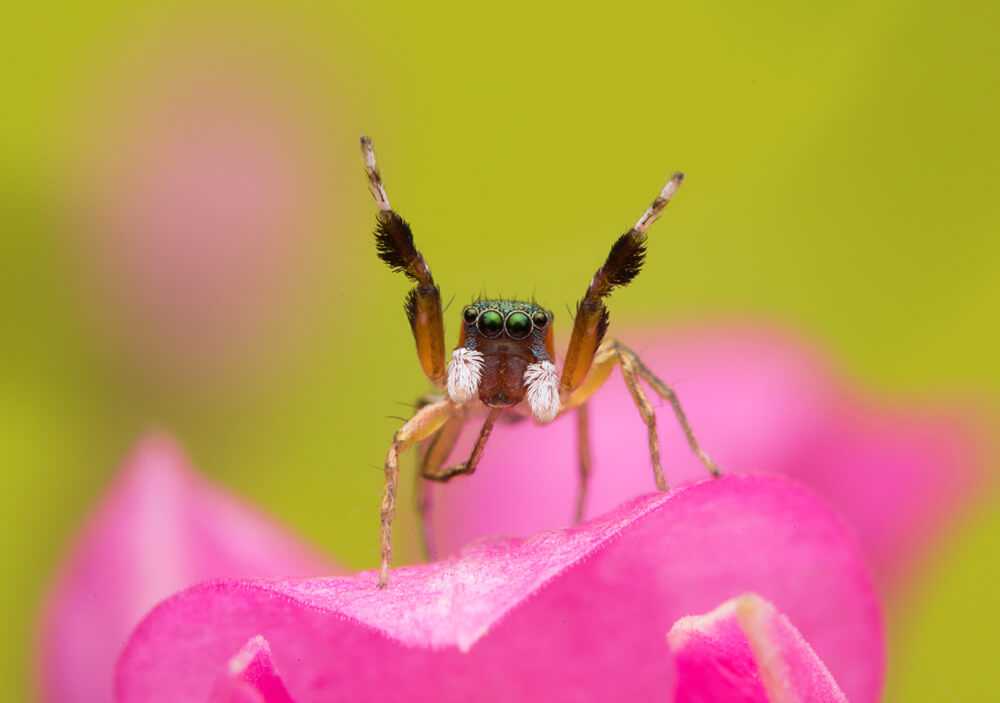
Jumping spiders, belonging to the family Salticidae, represent the most sizable spider family with more than 6,000 species that stand out due to their superior visual capabilities. These spiders make up the broadest category among all spiders globally and display a remarkable array of behaviors and adaptations.
Phidippus audax, known as the Bold jumper, is a widely recognized member within this group. It can be easily spotted by its prominent eyes and distinct black hue with an often-present white triangular mark on its abdomen. This particular species is not just prevalent across North America, but has also expanded its reach to other regions like Hawaii and the Netherlands, which reflects its great adaptability and popularity.
Human Interactions
Jumping spiders, though typically harmless to humans, may occasionally have interactions resulting in a bite. Symptoms from such bites usually manifest as mild swelling and discomfort at the impacted location. It is unusual for individuals to experience severe reactions. Vigilance for infection or allergic responses following a jumping spider bite is recommended even though these incidents are infrequent.
To alleviate any swelling and mitigate discomfort caused by the bite of jumping spiders, applying a cold compress can be beneficial. Should symptoms persist or deteriorate over time, consulting with healthcare professionals becomes necessary to eliminate concerns regarding potential allergies.
While they might look daunting to some people due to their appearance, most human encounters with these captivating creatures do not result in conflict.
Conservation Status
Jumping spiders are not considered to be a threatened group, and many species are found in a wide range of habitats around the world. However, some species of jumping spiders are found in specific ecosystems that are under threat, such as tropical rainforests or coral reefs. As a result, conservation efforts are necessary to protect these ecosystems and the jumping spider species that depend on them. Additionally, some species of jumping spiders are popular among collectors and hobbyists, which can lead to over-collection and population decline. As a result, it is essential to ensure that any collection or trade of jumping spiders is done sustainably and responsibly.
Interesting Facts About Jumping Spiders
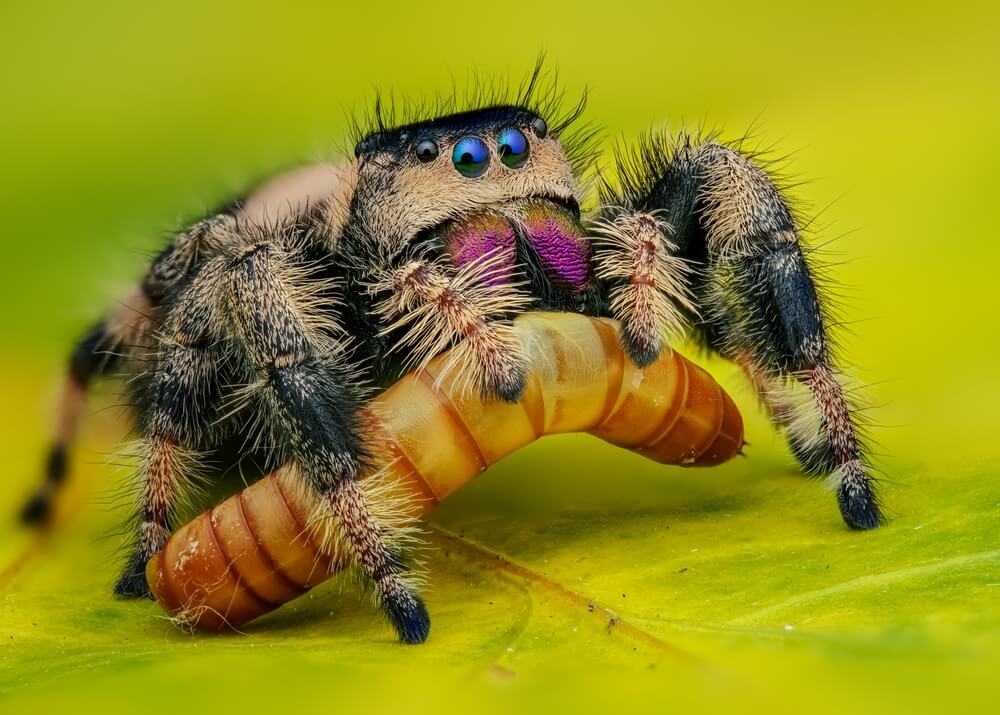
Jumping spiders employ their silk for multiple functions, not only to provide safety lines while leaping, but also for constructing shelters and aiding in their hunting techniques. Their versatility and ingenuity in various settings are highlighted by the multipurpose production of silk.
The extraordinary visual capabilities of jumping spiders set them apart as they boast the sharpest eyesight among all spider species. This superior vision plays a crucial role in allowing precise hunts and adept environmental navigation. Coupled with their aptitude for jumping, these attributes render them incredibly intriguing and formidable predators within the realm of arachnids.
Frequently Asked Questions
How do jumping spiders catch their prey?
Jumping spiders catch their prey by using their remarkable vision and agility to stalk them before delivering a powerful leap, often up to 40 times their body length, to make the capture.
This method allows them to surprise insects effectively.
Where do jumping spiders live?
Jumping spiders are adaptable and can be found in a variety of habitats worldwide, thriving in warm and sunny areas, including forests, urban structures, and leaf litter.
They do not inhabit extreme polar regions.
What should I do if I get bitten by a jumping spider?
If bitten by a jumping spider, it’s crucial to apply a cold compress to minimize swelling and pain.
Keep an eye on the bite for any signs of infection, and seek medical attention if the symptoms worsen.
What are some common species of jumping spiders?
Belonging to the vast Salticidae family, which encompasses more than 6,200 jumping spider species, the Bold jumper (Phidippus audax) is one of many. These spiders are known for their prominent eyes and unique color patterns.
How do jumping spiders reproduce?
Jumping spiders reproduce through elaborate courtship displays by males, including dances and vibrations to entice females.
After mating, females have the ability to store sperm and produce multiple egg sacs, facilitating the continuation of their lineage.
"*" indicates required fields
"*" indicates required fields
